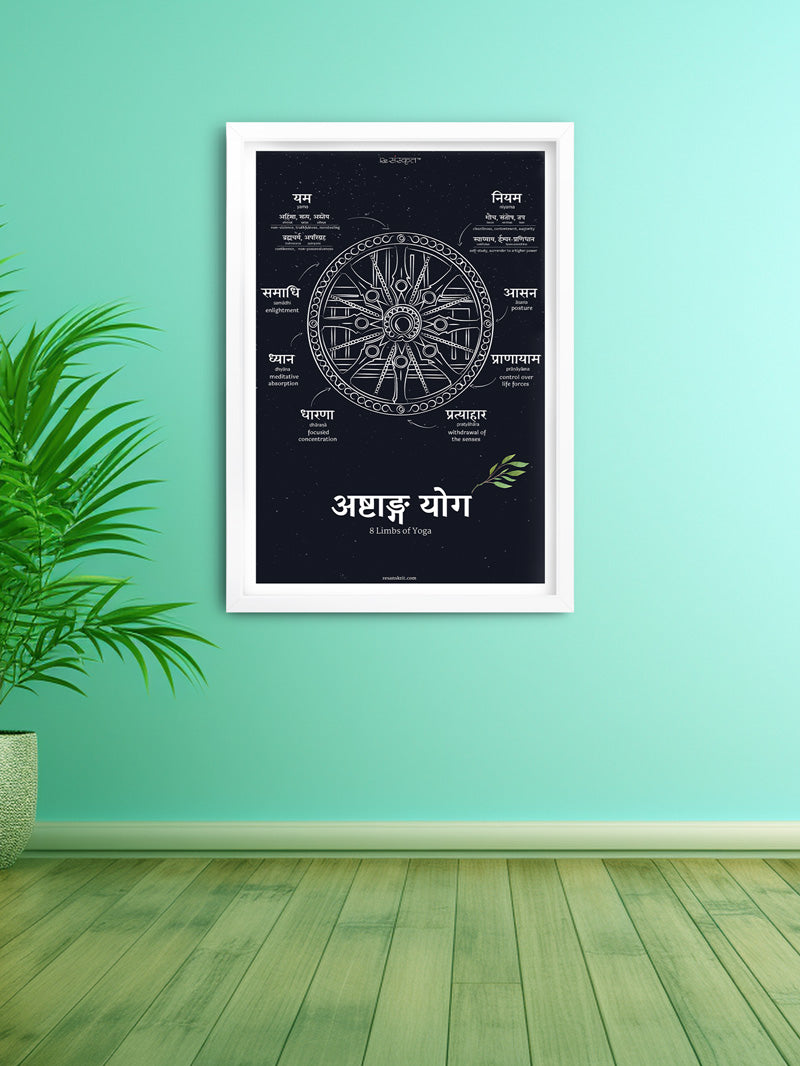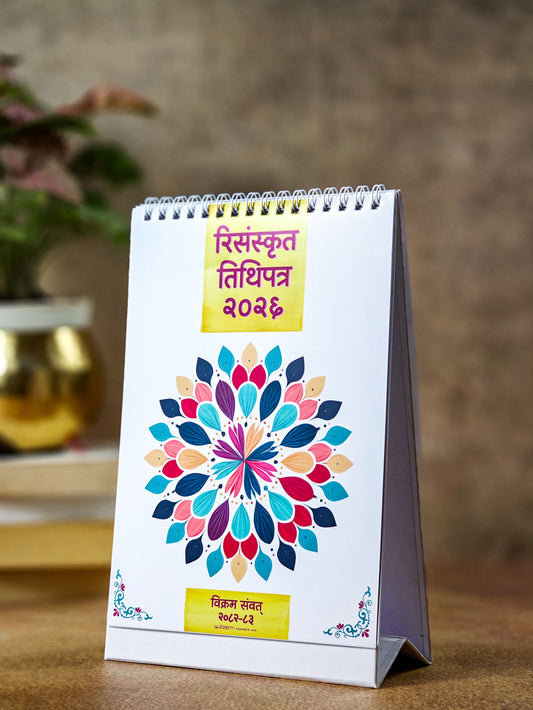Daily Yoga Practices for Mental Health: Ancient Wisdom for Modern Well-Being

Introduction
योगश्चित्तवृत्तिनिरोधः।
yogaścittavṛttinirodhaḥ
योग का अर्थ है मन के विचारों अर्थात विवेक का पूर्ण संयम।
Yoga means the complete restraint of the thoughts of the mind i.e. conscience.
Stress, worry and emotional exhaustion are becoming more common in the current world we live in. योग/Yoga is an ancient practice, focused on breathing, and helps us keep a calm mind. This article presents daily yoga practices that can teach us to slow down in this busy life and find peace and emotional stability. The renowned ancient tex योग सूत्र (Yoga Sutra) of पतञ्जलि (Patañjali), structured in 196 sutra provides theoretical and practical wisdom of what Yoga is. The sage Patañjali's ancient words offer a complete structure for awareness of the mind and the practices that lead to self-realisation and holistic health.
This article begins by introducing the readers to the history of Yoga. In the next part, we see how mental well-being and its importance are explained in the treatise's first chapter. Further, we dive into the अष्टाङ्ग योग (Aṣṭāṅga Yoga) i.e. eight parts of Yoga with a brief explanation and their role in mental well-being. The next part is an extensive list of Yoga poses and we conclude with scientific evidence from Western and Indian studies about Yoga and its effect on mental well-being.
History of Yoga
Before Patañjali, the science of Yoga was already present in various rituals established by Vedic sages. Numerous records indicate that Yoga has existed since the Ṛgvedic era. The earliest mentions of Yoga can be found in the ऋग्वेद (Ṛgveda), where it is associated with discipline, spiritual practice, and inner transformation:
योगे योगे तवस्तरं वाजे वाजे हवामहे।
सखय इन्द्रमूतये॥
yoge yoge tavastaraṃ vāje vāje havāmahe
sakhaya indramūtaye
एक सामान्य ज्ञान वाले एक समान गुण कर्म स्वभाव वाले, योग पथ के पथिक, एक ही साधना की राह के राहगीर, हम अपने अपने योग में अर्थात अपने योग मार्ग के प्रत्येक कर्म में और उस मार्ग में आई हुई प्रत्येक कठिनाई में प्रत्येक संघर्ष में अपनी रक्षा के लिए अपनी सफलता के लिए अत्यंत बलशाली होकर बलवान इंद्र परमेश्वर को बुलाते हैं।
People with common knowledge, having similar qualities, actions and nature, travellers on the path of yoga, travellers on the same path of sadhana, we call upon the powerful Indra Parmeshwar for our protection and success in our respective yoga i.e. in every action of our yoga path and in every difficulty and struggle faced in that path.
References to Yoga can also be found in the भगवद्गीता (Bhagavadgītā) like:
योगः कर्मसु कौशलम्।
yogaḥ karmasu kauśalam
योग ही कर्मों में कुशलता है।
Yoga is skill in action.
समत्वं योग उच्यते।
samatvaṃ yoga ucyate
समभाव ही योग कहलाता है।
Evenness of mind is called Yoga.
Sage Patañjali collected and systematised these ancient teachings and composed the great treatise known as the योगसूत्र (Yogasutra). This text is a guide on how to handle oneself, meditation techniques, and methods for attaining spiritual liberation. It continues to be an essential source of insights for yoga practitioners and spiritual seekers around the world.
The word योग (yoga) is derived from the Sanskrit root युज् (yuj). Pāṇini’s dhātupatha provides three meanings of this verbal root: 1. समाधि (Samādhi) meaning meditation, 2. युजिँर् योगे (yuji~r yoge) ‘to combine, to join, or to unite’, & 3. संयम (saṃyama) meaning ‘self-control’. All three meanings are widely used in all kinds of śāstra. Some scholars suggest that it means the union of the individual self (ātman) with the supreme consciousness (Brahman), while others state that it is about creating harmony between the body, mind, and spirit. From the above meanings, it is clear that Yoga is not only a physical discipline but also involves much more; awareness about the body and mind, and also of the universe. Through dedicated practice, Yoga helps individuals transcend the distractions of daily life, cultivate inner peace, and experience a profound sense of unity with the cosmos. This ancient science continues to be a transformative force, guiding practitioners toward self-realisation and ultimate well-being.
Fundamentals of Mental Health in Yogasutra
The verse 1.30 begins by pointing out the nine obstacles or distractions for the mind i.e. चित्तविक्षेप (cittavikṣepa).
व्याधिस्त्यानसंशयप्रमादालस्याविरतिभ्रान्ति
दर्शनालब्धभूमिकत्वानवस्थितत्वानि
चित्तविक्षेपास्तेऽन्तरायाः।
vyādhistyānasaṃśayapramādālasyāviratibhrānti
darśanālabdhabhūmikatvānavasthitatvāni cittavikṣepāste'ntarāyāḥ
चित्त के नौ विक्षेप या योग के प्रमुख अवरोध हैं- व्याधि (रोग), मानसिक जड़ता, संदेह, प्रमाद, आलस्य, विषयतृष्णा, मिथ्या अनुभव, समाधि की अनुपस्थिति, और समाधि में स्थिर न रह पाने जैसी बाधाएं।
The nine distractions of the mind or obstacles to Yoga are disease, mental inertia, doubt, negligence, laziness, sensual desires, false experiences, absence of Samādhi and inability to remain steady in Samādhi.

We shall look at these nine factors in detail below:
Let us now examine these nine factors in detail:
- व्याधि (Vyādhi) — Disease:
Physical illness or disease can disturb the mind to a great extent, making it difficult for an individual to concentrate on yogic practices. Taking care of oneself is very important to have a balanced and healthy mentality.
- स्त्यान (Styāna) — Mental Inertia:
Mental sluggishness or lethargy will keep us away from the progress of yoga. This barrier arises when one is not interested or motivated to practice, leading to a dormant mind.
- संशय (Saṃśaya) — Doubt:
Self-doubt, doubt in the teachings, or in the path of yoga can create confusion and weaken one's resolve. It takes faith, clarity, and conviction in the practice to overcome doubt.
- प्रमाद (Pramāda) — Negligence:
Carelessness or negligence in practice can lead to mistakes and inconsistencies, which destroy the integrity of the process. Being aware and considerate is crucial to avoid this pitfall and continue progressing.
- आलस्य (Ālasya) — Laziness:
Laziness can be a barrier for yoga practice. Hence it is required to be disciplined to overcome laziness.
- अविरति (Avirati) — Sensual Desires:
Excessive desires and pleasures create a distraction for yoga practice. In order to overcome this, one needs to instill detachment.
- भ्रान्ति दर्शन (Bhrānti Darśana) — False Experiences:
When you are confused and deluded, you misconstrue or misunderstand everything that occurs in practice. This needs clarity and a proper grasp of the teachings.
- अलब्ध भूमिकत्व (Alabdha Bhūmikatva) — Absence of Samādhi:
The inability to achieve or sustain Samādhi (deep meditative absorption) can be another challenge. Consistent practice is essential to reach and maintain this state.
- अनवस्थितत्व (Anavasthitatva) — Inability to Remain Steady in Samādhi:
Once Samādhi is achieved, the challenge lies in maintaining it. This can only be achieved through practice and mindfulness.
Addressing these nine obstacles, one can progress on the path of yoga and achieve a calm, focused, and clear mind. This knowledge is crucial for practitioners to navigate the challenges they may encounter and to cultivate a deeper connection with their inner selves.
Sage Patañjali has put a systematic order of obstacles and this order is very scientific. If one is suffering from a disease, then he can neither sit for yoga practice nor have an inclination towards yoga due to his mental state not being right, hence Patañjali has called disease as the first obstacle. Therefore, first of all, he/she has to become aware of their health and cure the body, only then one can take the first step on the path of yoga.
मैत्रीकरुणामुदितोपेक्षाणां सुखदुःखपुण्यापुण्यविषयाणाम्भावनातश्चित्तप्रसादनम्।
maitrīkaruṇāmuditopekṣāṇām sukhaduḥkhapuṇyāpuṇyaviṣayāṇāmbhāvanātaścittaprasādanam
सुख के प्रति मैत्री, दुःख के प्रति करुणा, पुण्य के प्रति प्रसन्नता, तथा पाप के प्रति उपस्थिति और ध्यान रखने से मन में स्पष्टता आती है।
Embodying friendliness toward (the object of) happiness, compassion toward pain, joy toward virtue, and presence and attention toward vice brings the clarification of the mind.

Let us explain each factor stated in the verse above:
- मैत्री (Maitrī) — Friendliness Towards Happiness:
Physical illness or disease can disturb the mind to a great extent, A friendly and joyful atmosphere towards the happiness and successes of others. When we genuinely feel happiness for other people's good fortune, we do not have feelings of jealousy or other negative ones.
- करुणा (Karuṇā) — Compassion Toward Pain:
Compassion and empathy towards those who are in pain develop our humility. When one feels someone's sorrows their indifference or passiveness reduces.
- मुदिता (Muditā) — Joy Toward Virtue:
A sense of joy and contentment toward virtuous qualities in others. Recognising goodness in someone creates positive vibes and decreases a pessimistic approach towards looking at the world.
- उपेक्षा (Upekṣā) — Equanimity Toward Vice:
Keeping equanimity and being impartial towards vice, misconduct or negative traits. Rather than looking at these things with anger, we can choose to be rational and balanced.
We come to an understanding that these things should not hamper our mental health.
With this attitude, one can achieve चित्तप्रसादनम् (cittaprasādanam), which refers to a state of still, pleasant, and serene mind. It helps one prepare for deeper meditation practices and self-awareness.
Whenever there is a discussion on how to attain happiness of mind, this sutra will be mentioned first. The sutra says that in this world you will encounter four types of people and you will have to behave with those four types of people keeping a certain point of view in mind.
-
सुखी (sukhī): — You will have to have a friendly attitude towards a person who seems happy.
-
दुःखी (duḥkhī): —You will have to have a feeling of compassion towards a person who seems sad.
-
पुण्यात्मा (puṇyātmā): —You should have a feeling of happiness towards those who are virtuous.
-
पापात्मा (pāpātmā): —You should have a feeling of indifference towards those who are sinful
and are involved in sin.
Thus this sutra points out how one should behave and how he should keep his mind calm and peaceful while dealing with each of the above.
To sum up the discussion, the essence of Yoga goes beyond physical āsanas; it is majorly rooted in mental health and wellness.
Let us look at the various aspects which promote mental well-being and self-awareness.

Bring Sanskrit home!
Get this Yoga Frame at just ₹ 599.
See
More!
अष्टाङ्ग योग (Aṣṭāṅga Yoga) for mental health-being:
As stated in the Yoga Sutras, the Aṣṭāṅga Yoga practice has a specific technique for achieving the overall wellness of the body and the mind. This eightfold path includes of Yama (ethical restraints), Niyama (self-discipline),āsana (physical postures), Praṇāyama (breath control), Pratyāhāra (withdrawal of senses), Dharana (concentration), Dhyāna (meditation), and Samādhi (ultimate absorption) as fundamental means for managing the workload stress in contemporary society.
यमनियमासनप्राणायामप्रत्याहारधारणाध्यानसमाधयोऽष्टावङ्गानि
YamaniyamāsanaPraṇāyamaPratyāhāradhāraṇāDhyānasamādhayo'ṣṭāvaṅgāni
यम, नियम, आसन, प्राणायाम, प्रत्याहार, धारणा, ध्यान और समाधि -आठ योग के अंग हैं।
Yama, Niyama,āsana, Praṇāyama, Pratyāhāra, Dhāraṇā, Dhyāna, Samādhi; are the eight parts of Yoga.
Here’s a detailed explanation of each:
1. Yama (Ethical Restraints) – Social Discipline
These are moral principles that guide our interactions with others and help in cultivating harmony in society. The five Yamas are described in the Yogasutra 2.30:
- अहिंसा Ahimsā (Non-violence) – Avoiding harm in thought, word, and action.
- सत्य Satya (Truthfulness) – Speaking and living truthfully.
- अस्तेय Asteya (Non-stealing) – Not taking what does not belong to us.
- ब्रह्मचर्य Brahmacarya (Celibacy/Moderation) – Exercising self-control in desires and sensory pleasures.
- अपरिग्रह Aparigraha (Non-possessiveness) – Letting go of material attachments and greed.
2. Niyama (Personal Observances) – Self-Discipline
These are personal habits that lead to self-purification and spiritual progress. Yogasutra 2.32 states the five Niyamas as follows:
- शौच śauca (Purity) – Cleanliness of body, mind, and surroundings.
- संतोष saṁtoṣa (Contentment) – Finding happiness in simplicity and acceptance.
- तप Tapa (Self-discipline) – Practicing perseverance and dedication.
- स्वाध्याय svādhyāya (Self-study) – Studying sacred texts and self-reflection.
- ईश्वर प्राणिधान īśvara praṇidhāna (Surrender to the Divine) – Trusting and surrendering to the higher power.
3. āsana (Physical Postures) – Body Discipline
The practice of āsanas (physical postures) in yoga has been scientifically proven to provide numerous benefits for
stress management. As outlined in the Patañjali Yoga Sutras (2.46): स्थिरसुखम् आसनम् (sthirasukham āsanam) meaning
posture(āsana) is that which is steady and pleasant. āsana is a posture, promotes physical stability, relaxation,
and mental calmness. Further the verse 2.48: ततो द्वन्द्वानभिघातः (tato dvandvānabhighātaḥ) This verse emphasise the
ability to remain balanced and composed amid contrasting experiences such as heat and cold, joy and sorrow, pain and
pleasure, and success and failure. By cultivating stability and detachment from these dualities, individuals can
effectively regulate their responses and manage stress in their lives. The list of āsanas is provided further in
detail for better mental health management.
4. Praṇāyama (Breath Control) – Energy Regulation
Praṇāyama is the regulation of breath to control the life force (prana). Yogasutra 2.49 says: तस्मिन्सति
श्वासप्रश्वासयोर्गतिविच्छेदः प्राणायामः (tasminsati śvāsapraśvāsayorgativicchedaḥ praṇāyamaḥ) meaning ‘controlling
the motion of the exhalation and the inhalation once this (āsana) is accomplished. This is Praṇāyama’. By practising
different breathing techniques, one can calm the mind, reduce stress, and increase vitality.
5. Pratyāhāra (Withdrawal of Senses) – Turning Inward
This stage helps in detaching the senses from external distractions and directing attention inward
Verse 2.54 state: स्वविषयासंप्रयोगे चित्तस्वरूपानुकार इवेन्द्रियाणां प्रत्याहारः (svaviṣayāsaṃprayoge
cittasvarūpānukāra ivendriyāṇāṃ pratyāhāraḥ)
By controlling our responses to sensory stimuli, we can achieve
better concentration and inner peace.
6. Dhāraṇā (Concentration) – Focused Attention
Yogasutra 3.1 talks about concentration: देशबन्धश्चित्तस्य धारणा (deśabandhaścittasya dhāraṇā)
Dhāraṇā is holding the mind to one place, object or point. This could be focusing on the breath, a mantra, or an
image of a deity. It trains the mind to remain steady and undisturbed, preparing it for meditation.
7. Dhyāna (Meditation) – Continuous Awareness
This is the practice of deep, uninterrupted meditation, where the mind remains fully absorbed in the object of focus.
In the sutra 3.2, the meaning is stated as:
तत्र प्रत्ययैकतानता ध्यानम् (tatra pratyayaikatānatā dhyānam) - the
unbroken flow of similar mental modifications is called Dhyāna.
It enhances self-awareness, inner tranquillity,
and a connection with the higher self.
8. Samādhi (Ultimate Absorption) – Spiritual Liberation
The verse 3.3 sums up the last part:
तदेवार्थमात्रनिर्भासं स्वरूपशून्यमिव समाधिः (tadevārthamātranirbhāsaṃ svarūpaśūnyamiva samādhiḥ)
The final stage of yoga, Samādhi , is the state of complete absorption, where the meditator merges with the object
of meditation.
The three (Dhāraṇā , Dhyāna and Samādhi) together on the same object is called Saṃyama.
त्रयमेकत्र संयमः
trayamekatra saṃyamaḥ (3.4)
In the modern world, people are continually exposed to demanding and high-paced environments with constant deadlines and distractions. Ashtanga Yoga can be useful in these situations. Techniques such as breath control (Praṇāyama) assists with managing the nervous system, calms the body, and decreases feelings of anxiety. Meditation (Dhyāna) promotes being in the present moment, improves emotions and focus, as well as emotional strength. The holistic concepts of Yama and Niyama stress on serving a balanced way of living where a person can refrain from violence, speak the truth, be self-satisfied, and practice self-control, all of which ensures mental tranquility.
Aṣṭāṅga Yoga is a step-by-step path that helps individuals develop ethical living, physical health, mental clarity, and spiritual awakening. By incorporating these eight limbs into daily life, one can achieve inner peace, self-mastery, and ultimate enlightenment.
We shall talk about the various yoga postures which are proven to help in stress management, mood swings and keeping overall mental well-being balanced.
List of yogāsana for improving Mental health
Yoga offers a variety of poses that help improve mental well-being by reducing stress, enhancing focus, and promoting
relaxation. Here are some effective yogāsanas for mental health prescribed by the Ministry of Ayush, Govt of
India
1 Ayush Govt Reference PDF
-
सूर्य नमस्कार (sūrya namaskāra): The ideal time to practise Surya Namaskar is at sunrise,
the most peaceful time of day. Whenever possible, practise in the open air, facing the rising sun. Sunset is
also a good time to practise as it stimulates the digestive fire. It is a holistic practice that integrates
movement, breath, and mindfulness, offering profound benefits for mental well-being.
Sūrya namaskāra consists of 12 positions as given below:

1. प्रणामासन (Praṇāmāsana) – Prayer Pose:
Stand with feet together, palms pressed together at the chest, spine straight, and shoulders relaxed.
2. हस्तोत्तानासन (Hastottānāsana) – Raised Arms Pose:
Inhale, raise both arms overhead, arching the back slightly while stretching the body upwards.
3. पादहस्तासन (Pādahastāsana) – Hand-to-Foot Pose:
Exhale, bend forward from the hips, and try to touch your palms to the floor beside your feet.
4. अश्वसञ्चालनासन (Aśvasañcālanāsana) – Equestrian Pose:
Inhale, step the right leg back, bending the left knee and keeping the chest lifted.
5. पर्वतासन (Parvatāsana) – Mountain Pose:
Exhale, bring both feet together and raise the hips towards the ceiling, forming an inverted ‘V’ shape.
6. अष्टाङ्ग नमस्कारासन (Aṣṭāṅga Namaskārāsana) – Salute with Eight Parts:
StLower knees, chest, and chin to the floor, keeping the hips raised and eight points touching the ground.
7. भुजङ्गासन (Bhujaṅgāsana) – Cobra Pose:
Inhale, slide forward, lifting the chest while keeping elbows bent and legs extended on the floor.
8. पर्वतासन (Parvatāsana) – Mountain Pose:
Exhale and lift the hips up to form an inverted ‘V’, pressing the heels toward the floor.
9. अश्वसञ्चालनासन (Aśvasañcālanāsana) – Equestrian Pose:
Inhale, step the left leg back, bend the right knee, and lift the chest.
10. पादहस्तासन (Pādahastāsana) – Hand-to-Foot Pose:
Exhale and bend forward from the hips, touching your palms to the floor beside your feet.
11. हस्तोत्तानासन (Hastottānāsana) – Raised Arms Pose:
Inhale, rise up with arms stretched overhead, arching the back slightly.
12. प्रणामासन (Praṇāmāsana) – Prayer Pose:
Exhale and return to the standing position with palms pressed together at the chest.
-
ताड़ासन (Tāḍāsana) – Palm Tree Pose:
This pose is named after the Tāḍa (Palm tree) as in the final posture, the body remains erect in a standing position like a palm tree. It helps stretch the muscles and nerves of the whole body and develops physical and mental balance.- Stand with feet together, arms by your sides, and spine straight; inhale, raise your arms overhead, stretch your entire body upward, and balance on your toes. Hold for a few breaths, then exhale and return to the starting position.
-
वृक्षासन (Vṛkṣāsana) – Tree Pose:
How to do it:
Stand straight, shift weight to one foot, and place the other foot on the inner thigh.
Join palms in Namaste and balance while keeping the gaze fixed ahead.
Hold for a few breaths and switch sides.
Benefits:
Enhances concentration and balance, improving mental stability.
Calms the nervous system and reduces stress.
How to do it:
Stand with feet hip-width apart and extend arms forward.
Twist your torso to one side, keeping your arms in line, then return and switch sides.
Benefits:
Improves spinal flexibility and relieves mental fatigue.
Helps release built-up tension and improves focus.
How to do it:
Sit with legs extended, inhale, and stretch your arms up.
Exhale, bend forward from the hips, and reach for your feet.
Benefits:
Reduces anxiety and calms the mind.
Helps in emotional balance and introspection.
How to do it:
Kneel on the mat, place hands on heels, and arch the back while looking upward.
Hold for a few breaths and return slowly.
Benefits:
Opens the heart centre, relieving stress and emotional blockages.
Boosts confidence and reduces feelings of depression.
How to do it:
Sit on heels, extend your arms forward, and lower your forehead to the floor.
Breathe deeply and relax in the posture.
Benefits:
Deeply calming and helps relieve anxiety.
Promotes relaxation and emotional stability.
How to do it:
Sit with legs extended, bend one knee, and place the foot across the opposite thigh.
Twist your torso toward the bent knee and hold.
Benefits:
Enhances spinal mobility and relieves tension.
Encourages mental alertness and clarity.
How to do it:
Sit with your knees stacked and hands clasped behind your back.
Keep your back straight and breathe deeply.
Benefits:
Helps release stored emotions and tension in the shoulders.
Improves patience and mental endurance.
How to do it:
Lie on your stomach, rest your head on crossed arms, and relax completely.
Benefits:
Induces deep relaxation and relieves mental fatigue.
Reduces anxiety and promotes a peaceful state of mind.
How to do it:
Lie on your stomach, place palms under your shoulders, and lift your chest upward.
Keep elbows slightly bent and shoulders relaxed.
Benefits:
Stimulates the nervous system and relieves fatigue.
Boosts confidence and uplifts mood.
How to do it:
Lie on your back, lift your legs over your head, and bring your toes toward the floor behind you.
Keep hands on the lower back for support.
Benefits:
Reduces stress and soothes the nervous system.
Enhances mental clarity and focus.
How to do it:
Lie on your back, lift your legs and torso, supporting your back with your hands.
Keep the body aligned and hold for a few breaths.
Benefits:
Balances the nervous system and improves blood circulation to the brain.
Helps relieve depression and anxiety.
How to do it:
Lie flat on your back, arms relaxed at your sides, and eyes closed.
Breathe deeply and focus on full-body relaxation.
Benefits:
Promotes deep relaxation and reduces stress.
Helps in emotional healing and enhances mindfulness.
These were some Yoga poses as mentioned by the Ministry of Ayush. Now, we shall look at the evidence-based studies of Yoga and mental health in the next section.
Scientific Insights and Studies
There are numerous scientific studies that highlight the benefits of yoga for mental health. Here are some key findings:
- Stress Reduction: A study led by Professor Ingunn Hagen from the Norwegian University of Science and Technology (NTNU)2 found that even a small amount of yoga can significantly reduce stress. The research showed that teenagers and working professionals felt more relaxed and better able to handle stress after practising yoga.
- Mood Improvement: Numerous studies have investigated the impact of yoga on mood regulation and its potential to alleviate mood swings. Research3 indicates that yoga can be an effective complementary therapy for managing mood disorders. For instance, a systematic review highlighted that yoga interventions can lead to significant reductions in symptoms of depression and anxiety.
- Cognitive Function: Research from Harvard Health4 indicates that yoga can improve cognitive skills such as learning, memory, and attention. MRI scans have shown that regular yoga practice can lead to a thicker cerebral cortex and hippocampus, which are areas of the brain involved in information processing and memory.
- Mental Balance and Resilience: Yoga helps activate the body's relaxation system, reducing the "fight or flight" response and promoting the "rest and digest" mode. This balance is essential for overall mental health and helps individuals cope better with difficult situations.
- General Mental Health:A comprehensive review published in the Journal of Ayurveda and Integrated Medical Sciences assessed the effectiveness of yoga as an intervention for improving mental health. The review included randomised control trials and experimental studies, showing that yoga significantly improves various aspects of mental health.
These studies collectively suggest that incorporating yoga into your routine can have profound benefits for mental health, including stress management, mood regulation, and overall mental balance.
Scientific References
2 Hagen, Ingunn. "How Can Social Expectations and Related Stress among Adolescents and Young Adults Be Better Coped with through Practicing Yoga?" Education and Human Development, IntechOpen, 14 Feb. 2024. Crossref, doi:10.5772/intechopen.113961.
3 Mary Ann Liebert, Inc.. "Yoga's ability to improve mood and lessen anxiety is linked to increased levels of a critical brain chemical, research finds." ScienceDaily, ScienceDaily, 12 November 2010. ScienceDaily Article.
4 Harvard Health - Yoga for Better Mental Health
5 Komal Kumari, and Sweta Pathak. "Effect of Yoga on Mental Health: An Overview". Journal of Ayurveda and Integrated Medical Sciences, Vol. 9, no. 11, Feb. 2025, pp. 186 -91, doi:10.21760/jaims.9.11.26.
Summary
Yoga is an ancient approach that has always been praised for its benefits on mental health. The key to basics of mental health in yoga stems from true inner balance, emotional regulation, and stress management using breathwork (Prāṇāyama), meditation (Dhyāna), and ethical practices (Yama and Niyama). Yogāsanas help slow down our nervous system, bring down anxiety, and maintain emotional balance. Scientific studies have also proven that yoga reduces stress, uplifts mood, and helps in treating mental illnesses associated with depression and anxiety through modulation of brain waves and enhancing productivity.





![[New Edition] ReSanskrit® 365 Days of Sanskrit Wisdom | Daily Sanskrit Quotes | With 100+ New Quotes, Hindi & English Translations🆕](http://resanskrit.com/cdn/shop/files/365-calendar-resanskrit-front-hero-shot_533x.jpg?v=1762351171)
![[New Edition] ReSanskrit® 365 Days of Sanskrit Wisdom | Daily Sanskrit Quotes | With 100+ New Quotes, Hindi & English Translations🆕](http://resanskrit.com/cdn/shop/files/365-calendar-resanskrit-quote-shot1_533x.jpg?v=1762351193)








![[Part 2] Relevant Sanskrit Shlokas with Meaning in Hindi & English](http://resanskrit.com/cdn/shop/articles/Relevant-Sanskrit-Shlokas-Article-Cover-image-part-2_4499da7e-f9d9-46a6-b615-35f58befb606_165x.jpg?v=1763476513)


2 Comments
The article is excellent! Yoga practices that combine ancient wisdom with modern mental-wellness needs are presented in clear, actionable detail.
Such an insightful post on the powerful benefits of yoga for mental health. The simple yet effective daily practices shared here can truly help anyone find balance and tranquility in their lives.
Leave a comment
Please note, comments need to be approved before they are published.